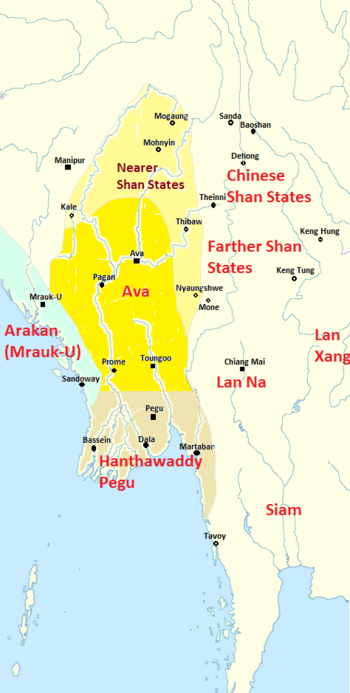مملكة هانثاوادي
Kingdom of Hanthawaddy Pegu ဟံသာဝတီ နေပြည်တော် | |||||||||
|---|---|---|---|---|---|---|---|---|---|
| 1287–1552 | |||||||||
 | |||||||||
 Hanthawaddy Kingdom ح. 1450 | |||||||||
| المكانة | مملكة | ||||||||
| العاصمة | Martaban (1287–1364) Donwun (1364–1369) Pegu (1369–1538, 1550–1552) | ||||||||
| اللغات الشائعة | Mon Burmese | ||||||||
| الدين | Theravada Buddhism | ||||||||
| الحكومة | Monarchy | ||||||||
• 1287–1307 | واررو | ||||||||
• 1384–1421 | Razadarit | ||||||||
• 1454–1471 | Shin Sawbu | ||||||||
• 1471–1492 | Dhammazedi | ||||||||
• 1492–1526 | Binnya Ran II | ||||||||
| الحقبة التاريخية | الدويلات المتناحرة | ||||||||
• الاطاحة بحاكم پگان | ح. يناير 1285 | ||||||||
• الاستقلال عن پگان | 30 يناير 1287 | ||||||||
• Vassal of سوخوتاي | 1287–1298, 1307–1317, 1330 | ||||||||
| 1385–1424 | |||||||||
• Golden Age | 1426–1534 | ||||||||
| 1534–1541 | |||||||||
• 2nd Fall of Pegu | 12 March 1552 | ||||||||
| |||||||||
مملكة هانثاوادي (بالبورمية: ဟံသာဝတီ နေပြည်တော်؛ Mon: ဟံသာဝတဳ؛ [hɔŋsawətɔe]؛ إنگليزية: Hanthawaddy Kingdom؛ وأيضاً Hanthawaddy Pegu أو ببساطة Pegu) كانت مملكة للـمون حكمت بورما (ميانمار) السفلى من 1287 إلى 1539 ومن 1550 حتى 1552. تأسست المملكة الناطقة بالـمون بإسم Ramaññadesa (بالبورمية: ရာမညဒေသ, Mon: ရးမည) على يد الملك واررو إثر انهيار مملكة پگان in 1287[1] as a nominal vassal state of the مملكة سوخوتاي and of the Mongol Yuan dynasty.[2] The kingdom became formally independent of Sukhothai in 1330 but remained a loose federation of three major regional power centres: the Irrawaddy Delta, Bago, and Mottama. ملوكها كانت سلطاتهم قليلة أو معدومة على توابعهم. Mottama was in open rebellion from 1363 to 1388.
التاريخ
العهد النشيط للملك Razadarit (r. 1384–1421) cemented the kingdom's existence. Razadarit firmly unified the three Mon-speaking regions together, and successfully fended off the northern Burmese-speaking Ava Kingdom in the Forty Years' War (1385–1424), making the western kingdom of Rakhine a tributary from 1413 to 1421 in the process. The war ended in a stalemate but it was a victory for Hanthawaddy as Ava finally gave up its dream of restoring the Pagan Empire. In the years following the war, Pegu occasionally aided Ava's southern vassal states of Prome and Taungoo in their rebellions but carefully avoided getting plunged into a full-scale war.
After the war, Hanthawaddy entered its golden age whereas its rival Ava gradually went into decline. From the 1420s to the 1530s, Hanthawaddy was the most powerful and prosperous kingdom of all post-Pagan kingdoms. Under a string of especially gifted monarchs – Binnya Ran I, Shin Sawbu, Dhammazedi and Binnya Ran II – the kingdom enjoyed a long golden age, profiting from foreign commerce. Its merchants traded with traders from across the Indian Ocean, filling the king's treasury with gold and silver, silk and spices, and all the other stuff of early modern trade. The kingdom also became a famous centre of Theravada Buddhism. It established strong ties with Sri Lanka and encouraged reforms that later spread throughout the country.[3]
The powerful kingdom's end came abruptly. From 1534 onwards, it came under constant raids by the Taungoo dynasty from Upper Burma. King Takayutpi could not marshal the kingdom's much greater resources and manpower against much smaller Taungoo, led by King Tabinshwehti and his deputy general Bayinnaung. Taungoo captured Bago and the Irrawaddy Delta in 1538–9, and Mottama in 1541.[4] The kingdom was briefly revived in 1550 after Tabinshwehti was assassinated. But the "kingdom" did not extend much outside the city of Bago. Bayinnaung quickly defeated the rebellion in March 1552.
Though Taungoo kings would rule all of Lower Burma well into the mid-18th century, the golden age of Hanthawaddy was fondly remembered by the Mon people of Lower Burma. In 1740, they rose up against a weak Taungoo Dynasty on its last legs, and founded the Restored Hanthawaddy Kingdom.
انظر أيضاً
المراجع
- ^ Coedès, George (1968). Walter F. Vella (ed.). The Indianized States of Southeast Asia. trans.Susan Brown Cowing. University of Hawaii Press. ISBN 978-0-8248-0368-1.
- ^ Htin Aung 1967: 78–80
- ^ Myint-U 2006: 64–65
- ^ Harvey 1925: 153–157
ببليوگرافيا
- Harvey, G. E. (1925). History of Burma: From the Earliest Times to 10 March 1824. London: Frank Cass & Co. Ltd.
- Htin Aung, Maung (1967). A History of Burma. New York and London: Cambridge University Press.
- Myint-U, Thant (2006). The River of Lost Footsteps—Histories of Burma. Farrar, Straus and Giroux. ISBN 978-0-374-16342-6.
- Pan Hla, Nai (1968). Razadarit Ayedawbon (in Burmese) (8th printing, 2005 ed.). Yangon: Armanthit Sarpay.
{{cite book}}: CS1 maint: unrecognized language (link)
- Short description is different from Wikidata
- Pages using infobox country or infobox former country with the flag caption or type parameters
- Former country articles categorised by government type
- Articles containing بورمية-language text
- Articles containing Mon-language text
- Pages using Lang-xx templates
- Articles containing إنگليزية-language text
- Articles with hatnote templates targeting a nonexistent page
- Myanmar articles missing geocoordinate data
- All articles needing coordinates
- مملكة هانثاوادي
- Former countries in Burmese history
- ممالك سابقة
- Burmese monarchy
- القرن 13 في بورما
- القرن 14 في بورما
- القرن 15 في بورما
- القرن 16 في بورما
- دول وأقاليم تأسست في 1287
- دول وأقاليم انحلت في 1552
- تأسيسات 1315 في آسيا
- انحلالات 1365 في آسيا